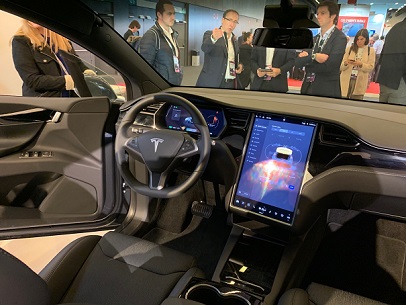As one wag put it at last year’s Mobile World Congress, “There sure are a load of mobile phones at this car show!” While drivers focused on the cars in Barcelona this year, the industry has been diving into the details of vehicle autonomy. And, as with so much at MWC19, says Jeremy Cowan, 5th Generation (5G) mobile communications is at the heart of it.
During #MWC19 the 5G Automotive Association (5GAA) gathered experts from the automotive, technology and telecom industries to explain how the deployment of ‘Cellular Vehicle-to-Everything’ (C-V2X) communication technology on the path to 5G is shaping future mobility. LTE-V2X, the initial version of C-V2X, is now close to commercial launch. It will allow vehicles to communicate with each other and their surroundings and, together with 5G enhancements, will facilitate broad improvements in road safety.
LTE-V2X
C-V2X communication is the new, high-speed cellular communications platform that enables vehicles to communicate with one another, with roadside infrastructure, and other road users (such as pedestrians, cyclists, and motorcyclists). It uses either direct short-range communications or cellular networks. While C-V2X network-based solutions are already widely deployed, direct communication solutions will be commercially available this year. The C-V2X platform is intended to deliver safety, mobility, traffic efficiency, and environmental benefits. C-V2X is designed with an evolutionary path to 5G.
“By bringing together key actors of the mobility ecosystem – across the automotive, information and communications technology industries – 5GAA continuously strives to develop forward-looking solutions for intelligent transportation services. Both for today and tomorrow,” says Thierry Klein, 5GAA vice chair and head of the Disruptive Innovation Program at Nokia Bell Labs. “These end-to-end integrated solutions bring enhanced safety, sustainability, and convenience to all road users. 5GAA is very excited to be pioneering the revolution towards a smarter and more connected mobility world,” he adds.
Tesla speeds away from horrors of 2018

Model X is a step up from the S in interior quality.
Tesla may wish to forget much about 2018, with troubles ranging from production bottlenecks that some Wall Street analysts predicted would bring the company down, through dwindling cash reserves and ill-advised tweets, to a joint smoked too publicly by CEO, Elon Musk. But, with assistance from some astute car-making hires in the second half of the year, the company is putting 2018 behind it and now claims to be producing around 1,000 of the well-received Model 3s a week. It hopes to manage 7,000 a week before 2019 is out.
Tesla showed its new-to-Europe electric sports utility vehicle (SUV), the Model X on its stand in Barcelona. Forget what you know about Tesla’s sizing from the Model S, this is a big vehicle with seating for seven. It also feels a step up in production quality. Yes, there’s still a disappointing ‘ting’ when you close the door (particularly with the frameless windows down) that you won’t find in comparable vehicles from other premium car makers like Audi, BMW and Mercedes, but the interior ambience from switchgear, dashboard, seating and the huge central screen are a notable improvement.
The company is not short of ambition. It is putting the finishing touches to its launch plans for Model Y (Tesla’s Models are S, 3, X, Y – see what they did there?), a smaller SUV based on the same platform and many of the same parts as the 3. It also has plans for a truck (a semi, for US readers), a pick-up and a new roadster.

Mercedes’ new electric crossover vehicle, the EQC, was also popular in Barcelona.
Mobile operators collaborate on solutions for car makers
Meanwhile, mobile network operators are getting their act together in readiness for 5G. AT&T and Vodafone Business are working together to accelerate Internet of Things (IoT) connectivity and innovation in the automotive industry. The Tier-1 operators will bring together their expertise to develop connected car solutions and experiences for customers that they say will be “superior and consistent” across their combined footprints in North America, Europe and Africa.
Vehicle makers face numerous challenges when deploying connected car solutions across countries. Each market has different requirements and regulations, and it can be complicated for automakers to work across multiple network operators and vendors. So, the goal is to simplify the deployment process, improve operations, deliver innovative solutions, and make the network certification process easier.
“This alliance with Vodafone Business is a natural extension of our existing relationship,” says Chris Penrose, president, Internet of Things Solutions, AT&T. “We each have rich experience in connected vehicle technology. By working together, we can innovate faster and help our global customers bring connectivity, entertainment and telematics to more vehicles across our respective footprints.”
This is echoed by Stefano Gastaut, IoT director, Vodafone Business, who says, “Our work with AT&T will benefit automotive manufacturers and their customers around the world as we simplify processes and provide a consistent experience to accelerate IoT adoption in this fast-moving market. As technology complexity increases, this is the right time to make technology adoption easier for the automotive industry to help them achieve their business outcomes.”
The companies say they will prioritise projects to enhance safety, security and entertainment capabilities. The key areas of focus will be:
5G and autonomous vehicle technology
V2X capabilities (vehicle-to-everything)
In-vehicle entertainment
Connected car applications and services
Global service quality models
Connected car/ smart cities intersection.
The author is Jeremy Cowan, editorial director of IoT Now and VanillaPlus.
Comment on this article below or via Twitter: @IoTNow_OR @jcIoTnow
Leave a Reply